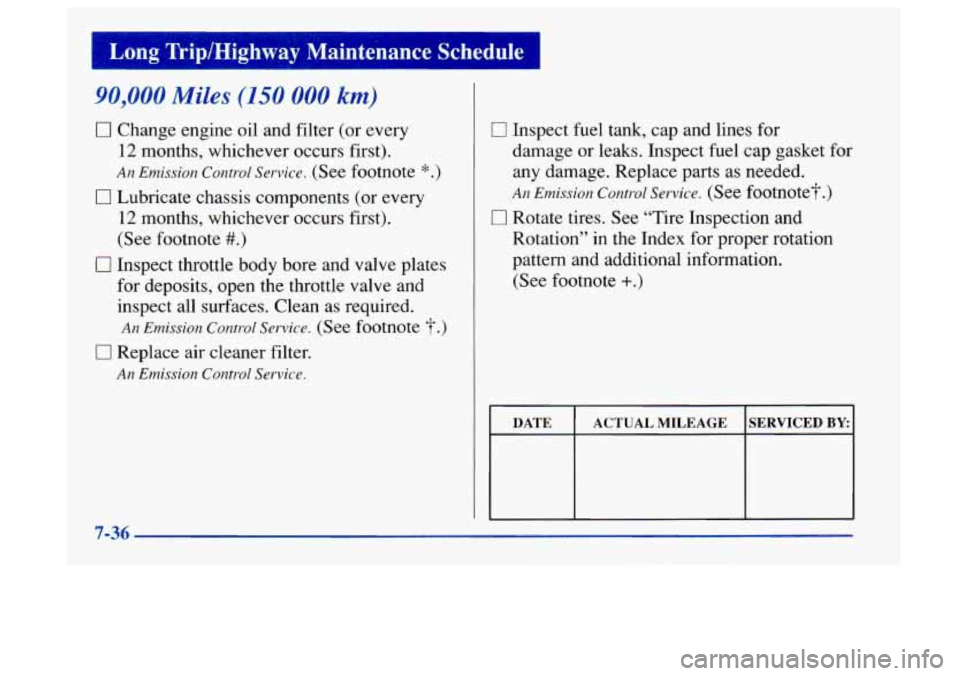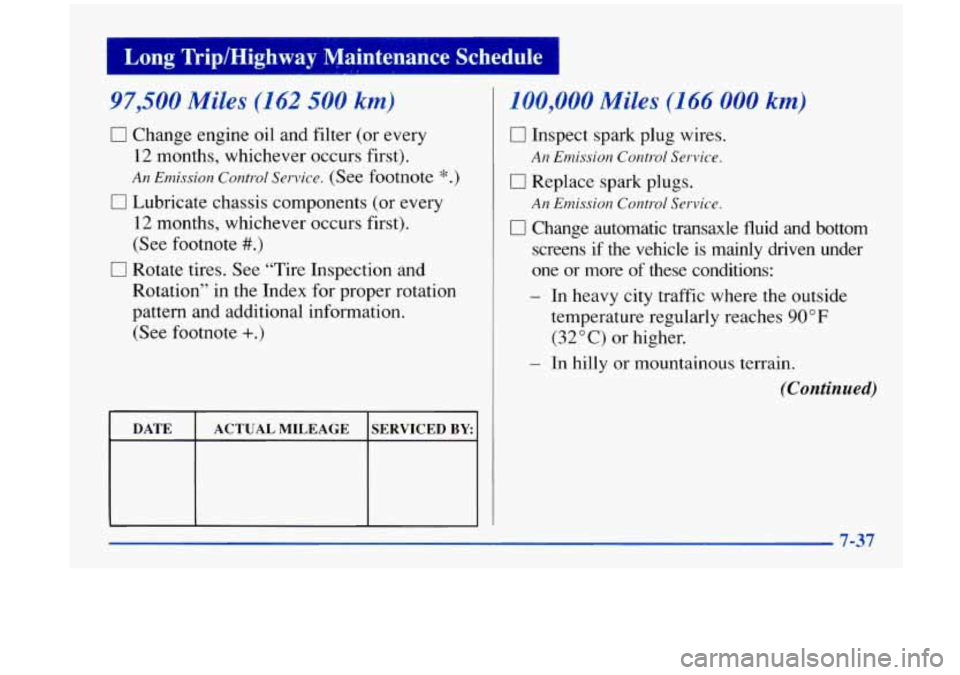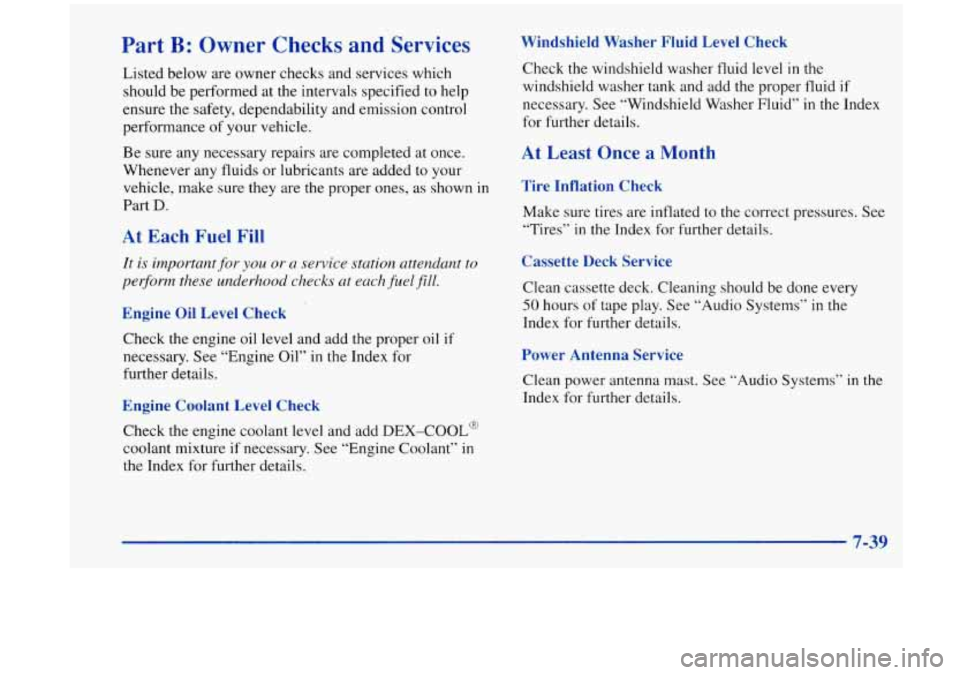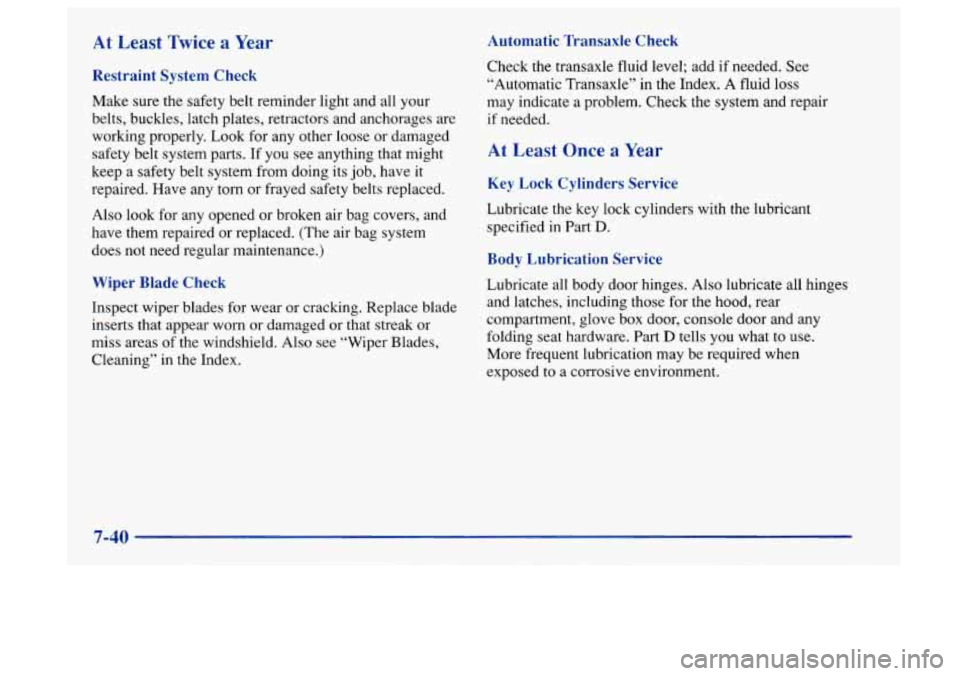Oldsmobile Aurora 1997 Owner's Manuals
Manufacturer: OLDSMOBILE, Model Year: 1997, Model line: Aurora, Model: Oldsmobile Aurora 1997Pages: 404, PDF Size: 20.75 MB
Page 361 of 404

I Long Trip/Highway Maintenance Schedule I
52,500 Miles (87 500 km)
0 Change engine oil and filter (or every
12 months, whichever occurs first).
An Emission Control Service. (See footnote *.)
0 Lubricate chassis components (or every
12 months, whichever occurs first).
(See footnote
#.)
0 Rotate tires. See “Tire Inspection and
Rotation” in the Index for proper rotation
pattern and additional infomation.
(See footnote
+.)
DATE ACTUAL MILEAGE SERVICED BY
60,000 Miles (100 000 km)
0 Change engine oil and filter (or every
12 months, whichever occurs first).
An Emission Control Service. (See footnote *.)
0 Lubricate chassis components (or every
12 months, whichever occurs first).
(See footnote
#.)
0 Inspect throttle body bore and valve plates
for deposits, open the throttle valve and
inspect all surfaces. Clean as required.
An Emission Control Service. (See footnote T.)
0 Rotate tires. See “Tire Inspection and
Rotation” in the Index for proper rotation
pattern and additional information. (See footnote
+.)
Inspect engine accessory drive belt.
An Emission Control Service.
(Continued)
7-33
Page 362 of 404

t
Long Trip/Highway Maintenance Schedule I
rn
60,000 Miles (I00 000 km) (Continued)
0 Replace air cleaner filter.
An Emission Control Service.
0 Inspect fuel tank, cap and lines for damage
or leaks. Inspect fuel cap gasket for any
damage. Replace parts as needed.
An Emission Control Service. (See footnote^.)
DATE ACTUAL
MILEAGE SERVICED BY:
67,500 Miles (112 500 km)
0 Change engine oil and filter (or every
12 months, whichever occurs first).
An Emission Control Service. (See footnote *.)
17 Lubricate chassis components (or every
12 months, whichever occurs first).
(See footnote
#.)
0 Rotate tires. See “Tire Inspection and
Rotation”
in the Index for proper rotation
pattern and additional information.
(See footnote
+.)
DATE ACTUAL MILEAGE
I I
SERVICED BY:
Page 363 of 404

I Long Trip/Highway Maintenance Schedule I
75,000 Miles (125 000 km)
0 Change engine oil and filter (or every
12 months, whichever occurs first).
An Emission Control Service. (See footnote *.)
0 Lubricate chassis components (or every
12 months, whichever occurs first).
(See footnote
#.)
17 Rotate tires. See “Tire Inspection and
Rotation” in the Index for proper rotation
pattern and additional information.
(See footnote
+.)
DATE SERVICED BY: ACTUAL MILEAGE
82,500 Miles (137 500 km)
0 Change engine oil and filter (or every
12 months, whichever occurs first).
An Emission Control Service. (See footnote *.)
0 Lubricate chassis components (or every
12 months, whichever occurs first).
(See footnote
#.)
0 Rotate tires. See “Tire Inspection and
Rotation’’ in the Index for proper rotation
pattern and additional information.
(See footnote
+.)
DATE SERVICED BY: ACTUAL MILEAGE
7-55
Page 364 of 404

I Long TriplHighway Maintenance Schedule 1
90,000 Miles (150 000 km)
0 Change engine oil and filter (or every
12 months, whichever occurs first).
An Emission Control Service. (See footnote *.)
0 Lubricate chassis components (or every
12 months, whichever occurs first).
(See footnote
#.)
0 Inspect throttle body bore and valve plates
for deposits, open the throttle valve and
inspect all surfaces. Clean as required.
An Emission Control Service. (See footnote T.)
0 Replace air cleaner filter.
An Emission Control Service.
0 Inspect fuel tank, cap and lines for
damage or leaks. Inspect fuel cap gasket
for
any damage. Replace parts as needed.
An Emission Control Service. (See footnote?.)
0 Rotate tires. See “Tire Inspection and
Rotation” in the Index for proper rotation
pattern and additional information.
(See footnote
+.)
DATE SERVICED BY: ACTUAL MILEAGE
7-36
Page 365 of 404

97,500 Miles (162 500 km)
0 Change engine oil and filter (or every
12 months, whichever occurs first).
An Emission Control Service. (See footnote *.)
0 Lubricate chassis components (or every
12 months, whichever occurs first).
(See footnote
#.)
0 Rotate tires. See “Tire Inspection and
Rotation” in the Index for proper rotation
pattern and additional information.
(See footnote
+.)
DATE SERVICED BY ACTUAL MILEAGE
100,000 Miles (1 66 000 km)
0 Inspect spark plug wires.
An Enlission Control Service.
0 Replace spark plugs.
An Emission Control Service.
c] Change automatic transaxle fluid and bottom
screens if the vehicle is mainly dnven under
one
or more of these conditions:
- In heavy city traffic where the outside
temperature regularly reaches
90 O F
(32°C) or higher.
- In hilly or mountainous terrain.
(Continued)
7-37
Page 366 of 404

~ Long-TriplHighway Maintenance Schedule 1
100,000 Miles (I 6t ued)
- When doing frequent trailer towing.
- Uses such as
found in taxi, police or
If you do not use your vehicle under any of
these conditions, the fluid and filter do not
require changing.
delivery service.
150,000 Miles (240 000 km)
0 Drain, flush and refill cooling system
(or every
60 months since last service,
whichever occurs first). See "Engine
Coolant''
in the Index for what to use.
Inspect hoses. Clean radiator, condenser,
pressure cap and neck. Pressure test
the cooling system and pressure cap.
An Emission Control Service.
DATE ACTUAL MILEAGE SERVICED BY:
7-38
Page 367 of 404

Part B: Owner Checks and Services
Listed below are owner checks and services which
should be performed at the intervals specified
to help
ensure the safety, dependability and emission control
performance of your vehicle.
Be sure any necessary repairs are completed at once.
Whenever any fluids or lubricants are added to your
vehicle, make sure they are the proper ones, as shown in
Part
D.
At Each Fuel Fill
It is important for you or a service station attendant to
perform these underhood checks at each fuel
fill.
Engine Oil Level Check
Check the engine oil level and add the proper oil if
necessary. See “Engine Oil” in the Index for
further details.
Engine Coolant Level Check Windshield Washer
Fluid Level Check
Check the windshield washer
fluid level in the
windshield washer tank and add the proper fluid if
necessary. See “Windshield Washer Fluid” in the Index
for further details.
At Least Once a Month
Tire Inflation Check
Make sure tires are inflated to the correct pressures. See
“Tires”
in the Index for further details.
Cassette Deck Service
Clean cassette deck. Cleaning should be done every
50 hours of tape play. See “Audio Systems” in the
Index for further details.
Power Antenna Service
Clean power antenna mast. See “Audio Systems” in the
Index for further details.
Check the engine coolant level and add DEX-COOL@
coolant mixture if necessary. See “Engine Coolant”
in
the Index for further details.
7-39
Page 368 of 404

At Least Twice a Year
Restraint System Check
Make sure the safety belt reminder light and all your
belts, buckles, latch plates, retractors and anchorages are
working properly. Look for any other loose or damaged
safety belt system parts.
If you see anything that might
keep a safety belt system from doing its job, have it
repaired. Have any torn or frayed safety belts replaced.
Also look for any opened or broken air bag covers, and
have them repaired or replaced. (The air bag system
does not need regular maintenance.)
Wiper Blade Check
Inspect wiper blades for wear or cracking. Replace blade
inserts that appear worn or damaged
or that streak or
miss areas of the windshield. Also see “Wiper Blades,
Cleaning” in the Index.
Automatic Transaxle Check
Check the transaxle fluid level; add if needed. See
“Automatic Transaxle” in the Index.
A fluid loss
may indicate a problem. Check the system and repair
if needed.
At Least Once a Year
Key Lock Cylinders Service
Lubricate the key lock cylinders with the lubricant
specified in
Part D.
Body Lubrication Service
Lubricate all body door hinges. Also lubricate all hinges
and latches, including those for the hood, rear
compartment, glove box door, console door and any
folding seat hardware. Part
D tells you what to use.
More frequent lubrication may be required when
exposed
to a corrosive environment.
7-40
Page 369 of 404

Starter Switch Check
A CAUTION: -
I
When you are doing this check, the vehicle could
move suddenly. If it does, you or others could be injured. Follow the steps below.
1.
2.
3.
Before you start, be sure you have enough room
around the vehicle.
Firmly apply both the parking brake (see “Parking
Brake”
in the Index if necessary) and the
regular brake.
NOTE:
Do not use the accelerator pedal, and be
ready
to turn off the engine immediately if it starts.
Try
to start the engine in each gear. The starter
should work only in PARK (P) or NEUTRAL (N). If
the starter works in any other position, your vehicle
needs service.
Brake-Transaxle Shift Interlock (BTSI) Check
I A CAUTION:
When you are doing this check, the vehicle could
move suddenly. If it does, you or others could be
injured. Follow the steps below.
1.
2.
3.
Before you start, be sure you have enough room
around the vehicle. It should be parked on a
level surface.
Firmly apply the parking brake (see “Parking Brake”
in the Index if necessary).
NOTE: Be ready
to apply the regular brake
immediately if the vehicle begins
to move.
With the engine off, turn the key to the RUN
position, but don’t start the engine. Without applying
the regular brake, try to move the shift lever out
of
PARK (P) with normal effort. If the shift lever
moves out of PARK (P), your vehicle’s BTSI
needs service.
7-41
I
Page 370 of 404

Ignition Transaxle Lock Check While parked, and with
the parking brake set, try to turn
the ignition key to
LOCK in each shift lever position.
The key should turn to LOCK only when the shift
lever
is in PARK (P).
0 The key should come out only in LOCK.
Parking Brake and Automatic Transaxle PARK (P)
Mechanism Check
When you are doing this check, your vehicle
could begin to move.
You or others could be
injured and property could be damaged. Make
sure there
is room in front of your vehicle in case
it begins
to roll. Be ready to apply the regular
brake at once should the vehicle begin to move. Park
on
a fairly steep hill, with the vehicle facing
downhill. Keeping your foot on the regular brake, set the
parking brake.
0 To check the parking brake’s holding ability: With
the engine running and transaxle in NEUTRAL
(N),
slowly remove foot pressure from the regular brake
pedal.
Do this until the vehicle is held by the parking
brake only.
To check the PARK (P) mechanism’s holding ability:
With the engine running, shift to
PARK (P). Then
release all brakes.
Underbody Flushing Service At least every spring, use plain water to
flush any
corrosive materials from the underbody. Take care to
clean thoroughly any areas where mud and other debris
can collect.
7-42